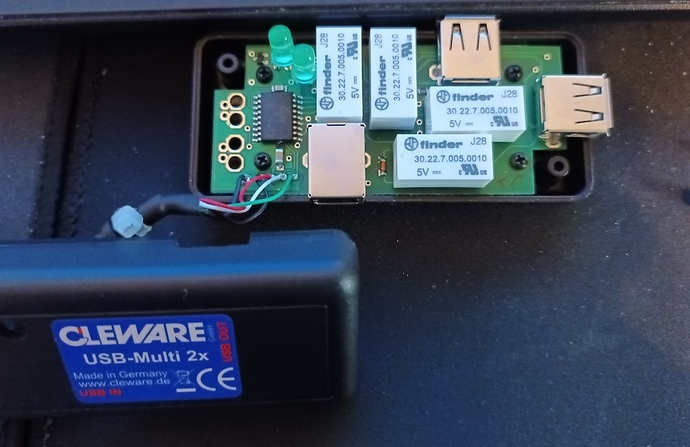A not-appium question really. Anyone gota great solution for keeping multiple attached USB devcies all nicely powered? MacMini seems to be limited to 2 ports to deliver full power/charge and keep tablet devices of both platforms powered properly. Any suggestions as to what devices are helpful hacks to keep things charged or connected and perhaps also still not cause a battery fire?
We were using https://www.amazon.com/Programmable-Industrial-Over-Current-Protection-mountable/dp/B01AKGE75W in the local lab. The power logic has been controlled by a script, which was enabling it by schedule. It could even be more sophisticated by measuring the actual device battery level.
Another solution might be to modify the device charging scheme itself to exclude the battery from the chain and power it directly from the power supply.
Nice. I saw similar devices, do they maintain charge on pro series ipads and big android tablets with only 5V supply? That’s a lot of money for a smart hub, are you happy with the hub being reliable?
Mostly have you popped the lid off, does it use jfet or does it use relays for the power switching? I’ll show you my device in a moment, it’s externally/self-powered, but it failed to charge the ipad pro tablet, it might not be negotiating USB power as I was expecting.
445$ wow
we use simple https://www.amazon.de/-/en/i-tec-Charging-16-Port-External-Adapter-16-connections/dp/B07N5K9VR1/ with two macMinis. one with 12 iPhones another one with 13 Android phones
PS the only minus battery on iPhones mostly dead (30-40% capacity from original) while Android phones have no issues. within 3y met swollen battery: 1 iPhone and 4 Android phones.
Never tried that with iPad Pro. Basically, the main idea is to avoid devices constantly being connected to the power supply because it negatively impacts their batteries. And this could be achieved in many different ways.
We’ve selected the above hub because it has quite flexible controlling logic and provides Python API for that. The price is so high, because this is an industrial device, which is optimised for work under extreme environmental conditions for longer time periods.
This is just a wire splitter, and so it won’t do USBC devices properly, not that that’s a huge issue, but it causes me worry for the lightning connector and apple doing unusual things later. That pic micro lets us swap which port is “live” or powered. Pretty cheap solution, but very limited.
We used these to protect the battery on devices, but I still have one of those famous exploding phone models which grew out of it’s case and I keep it as a warning now. I’ll defo look for a local supplier and grab a unit next year when I know what I’m doing with my device farm.
I am curious, What’s the maximum device you have tried to connect with macMini in one go and the test is still working?
Do you know the limited bandwidth for mac mini usb?
Adb limit is 16. So 16 android phones max by default. I read that it can be increased but never tried.
With ios dont know. 12 phones without issues so far.
Speed… problem mostly with install new app version. Our app about 170Mb (both ios and android similar) so for e.g. 12 phones it is 2Gb. Takes about 2 min. I think if connect to different usb hubs it should speedup but not tried.
The vanilla self-powered hubs won’t reliably and properly charge more than 3 tablets at once from my experience. I’m currently just wanting to keep about 8 devices on charge, but have software control over things, just for convenience and fun value really. Our test rig does not need more than 4 phones per mac machine, buying more macs is easier as that gives us more parallel processing power and test-lab redundancy anyway. But if we can handle many more, that would be a bonus, hence my rough starting question.
Just an idea maybe connect through device with wifi and charger can stack on top of those IOT wifi plug and control it from some script?
Today I got back from holiday and had to plug all my test phones in at once to charge them up after a long break. No fires luckily.
@Sarin_Suriyakoon do you have the maker name of such a device, yes wifi is an option. Anything is an option (and finding time too).
I looked at this forum https://iot.stackexchange.com/questions/3437/are-there-any-smart-electrical-plugs-with-an-open-api
Hope it helps!
Yeah, the difference is that we want the USB connection to the device to still be possible during a test execution. Basically want to stop charging (stop overcharging) all devices, and start charging them at least an hour before a test run starts - so that the test can talk to the device still over USB. Ideally we don’t want the device to “lock” or reboot either. But appium needs to be able to run over USB, without manual intervention as would be normal.
Have you tried to test the device via wifi network? I tried with a few devices and both ios and android work over wifi. Not sure how is it in real production with a “farm” size series of devices.
Nope, not tried to see if appium, ideviceinstaller, idevicescreenshot and adb can be made to work over Wifi. I assume they can, but not had time to look that far ahead.
